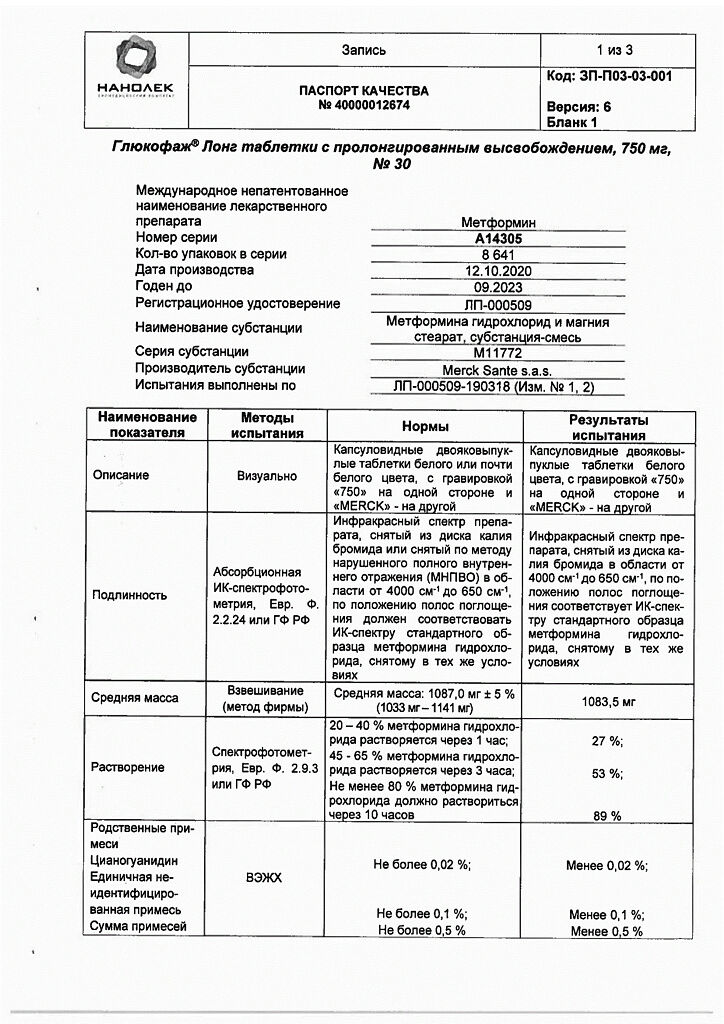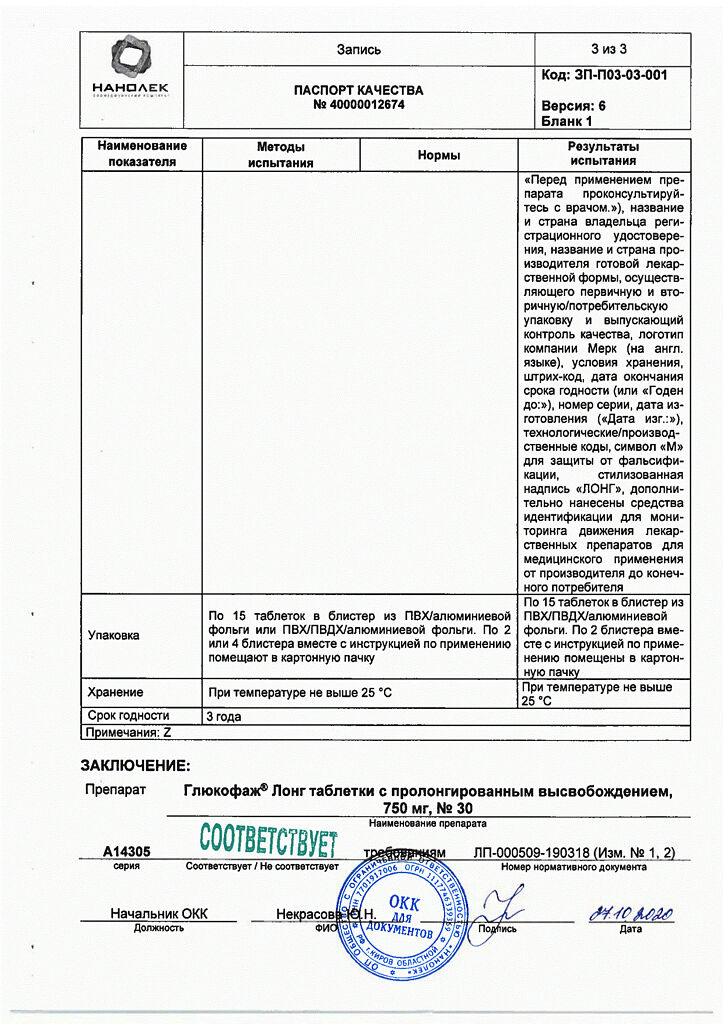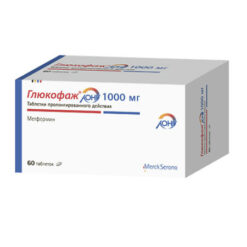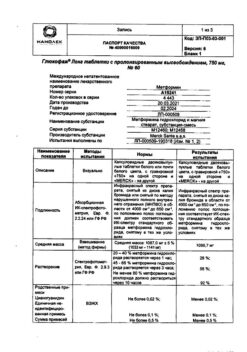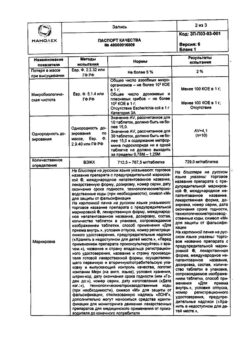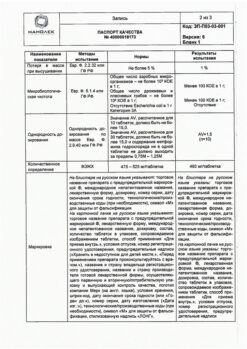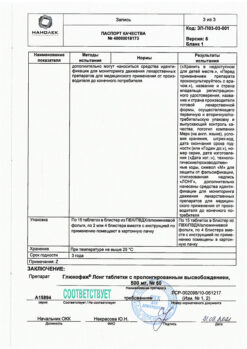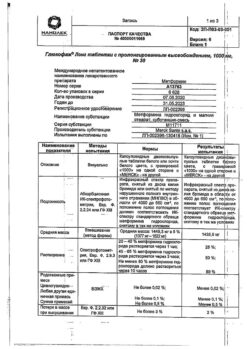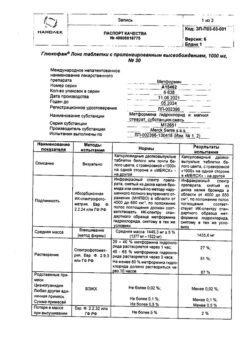No products in the cart.
Glucofage Long, 750 mg 30 pcs
€7.60 €6.33
Description
Oral hypoglycemic drug of the biguanide group, which reduces both basal and postprandial plasma glucose levels.
It does not stimulate insulin secretion and therefore does not cause hypoglycemia.
It increases the sensitivity of peripheral receptors to insulin and glucose utilization by cells.
Decreases glucose production by the liver by inhibiting gluconeogenesis and glycogenolysis. Delays absorption of glucose in the intestine.
Metformin stimulates glycogen synthesis by acting on glycogen synthetase. It increases transport capacity of all types of membrane glucose transporters.
With metformin administration, the patient’s body weight either remains stable or decreases moderately.
Metformin has a favorable effect on lipid metabolism: it reduces total cholesterol, LDL and triglycerides.
Pharmacokinetics
Intake
After oral administration of the drug in the form of sustained release tablet, metformin absorption is delayed compared to the tablet with normal metformin release. Time to reach Cmax of metformin when taking Glucofage® Long tablets is 7 hours. At the same time, Tmax for tablets with normal release is 2.5 h.
In the equilibrium state identical to Css of metformin in the form of tablets with a normal release profile, Cmax and AUC do not increase in proportion to the dose. After a single oral dose of 2000 mg of metformin in the form of sustained release tablets, the AUC is similar to that observed after taking 1000 mg of metformin in the form of normally-released tablets 2 times/day.
The Cmax and AUC fluctuations in individual patients when metformin is taken in the form of sustained release tablets are similar to those observed after taking tablets with normal release profile.
The absorption of metformin from sustained release tablets does not vary with food intake.
Distribution
The binding to plasma proteins is insignificant. Cmax in blood is lower than Cmax in plasma and is reached after approximately the same time. The average Vd ranges from 63-276 L.
There is no cumulation when repeatedly taking up to 2000 mg of metformin in the form of sustained release tablets.
Metabolism
No metabolites have been detected in humans.
The T1/2 after oral administration is about 6.5 h. Metformin is excreted unchanged by the kidneys. Renal clearance of metformin is >400 ml/min, indicating that metformin is excreted by glomerular filtration and tubular secretion.
Pharmacokinetics in special clinical cases
In impaired renal function, metformin clearance decreases in proportion to CK and T1/2 is increased, which may lead to increased metformin plasma concentrations.
Indications
Indications
Type 2 diabetes mellitus in adults with ineffective diet therapy and physical activity (especially in obese patients):
as monotherapy;
in combination with other oral hypoglycemic drugs, or in combination with insulin.
Pharmacological effect
Pharmacological effect
An oral hypoglycemic drug from the biguanide group, which reduces both basal and postprandial glucose levels in blood plasma.
It does not stimulate insulin secretion and therefore does not cause hypoglycemia.
Increases the sensitivity of peripheral receptors to insulin and the utilization of glucose by cells.
Reduces liver glucose production by inhibiting gluconeogenesis and glycogenolysis. Delays the absorption of glucose in the intestines.
Metformin stimulates glycogen synthesis by acting on glycogen synthetase. Increases the transport capacity of all types of membrane glucose transporters.
While using metformin, the patient’s body weight either remains stable or decreases moderately.
Metformin has a beneficial effect on lipid metabolism: it reduces the content of total cholesterol, LDL and triglycerides.
Pharmacokinetics
Suction
After oral administration of the drug in the form of an extended-release tablet, the absorption of metformin is slower compared to the regular-release tablet of metformin. The time to reach Cmax of metformin when taking Glucophage® Long extended-release tablets is 7 hours. At the same time, Tmax for regular-release tablets is 2.5 hours.
At steady state, identical to the Css of metformin tablets with a regular release profile, Cmax and AUC increase non-proportionally with dose. Following a single oral dose of 2000 mg metformin extended-release tablets, the AUC is similar to that observed after administration of 1000 mg metformin regular-release tablets twice daily.
Inter-patient variation in Cmax and AUC for metformin extended-release tablets is similar to that observed for regular-release tablets.
The absorption of metformin from extended-release tablets is not affected by food intake.
Distribution
Plasma protein binding is negligible. Cmax in the blood is lower than Cmax in plasma and is achieved after approximately the same time. Average Vd ranges from 63-276 hp.
No accumulation is observed with repeated doses of up to 2000 mg of metformin in the form of extended-release tablets.
Metabolism
No metabolites have been detected in humans.
Removal
After oral administration, T1/2 is about 6.5 hours. Metformin is excreted unchanged by the kidneys. The renal clearance of metformin is >400 ml/min, indicating that metformin is eliminated by glomerular filtration and tubular secretion.
Pharmacokinetics in special clinical situations
With impaired renal function, the clearance of metformin decreases in proportion to CC, T1/2 increases, which can lead to an increase in the concentration of metformin in plasma.
Special instructions
Special instructions
Lactic acidosis
Lactic acidosis is an extremely rare but serious (high mortality rate unless promptly treated) complication that can occur due to accumulation of metformin. Cases of lactic acidosis in patients receiving metformin occurred mainly in diabetic patients with severe renal failure.
Other associated risk factors should be considered, such as poorly controlled diabetes, ketosis, prolonged fasting, excessive alcohol consumption, liver failure and any condition associated with severe hypoxia. This may help reduce the incidence of lactic acidosis.
The risk of developing lactic acidosis should be taken into account when nonspecific signs appear, such as muscle cramps accompanied by dyspepsia, abdominal pain, general weakness and severe malaise.
Lactic acidosis is characterized by acidotic shortness of breath, vomiting, abdominal pain, muscle cramps and hypothermia followed by coma. Diagnostic laboratory parameters are a decrease in blood pH (5 mmol/l), increased anion gap and lactate/pyruvate ratio. If lactic acidosis is suspected, stop taking the drug and consult a doctor immediately.
Surgical operations
The use of metformin should be discontinued 48 hours before elective surgery and can be continued no earlier than 48 hours after, provided that renal function has been found to be normal during the examination.
Kidney function
Since metformin is excreted by the kidneys, before starting treatment, and regularly thereafter, it is necessary to determine CC: at least once a year in patients with normal renal function, and 2-4 times a year in elderly patients, as well as in patients with CC at the lower limit of normal.
Particular caution should be exercised in case of possible impairment of renal function in elderly patients, with simultaneous use of antihypertensive drugs, diuretics or NSAIDs.
Other Precautions
Patients are advised to continue to follow a diet with even carbohydrate intake throughout the day.
Overweight patients are advised to continue to follow a hypocaloric diet (but not less than 1000 kcal/day). Patients should also exercise regularly.
Patients should tell their doctor about any treatment they are undergoing and any infectious diseases such as respiratory or urinary tract infections.
Standard laboratory tests should be performed regularly to monitor diabetes mellitus.
Metformin does not cause hypoglycemia when used alone, but caution is recommended when used in combination with insulin or other oral hypoglycemic agents (for example, sulfonylureas or repaglinide). Symptoms of hypoglycemia include weakness, headache, dizziness, increased sweating, rapid heartbeat, blurred vision, or difficulty concentrating.
It is necessary to warn the patient that the inactive components of the drug Glucophage® Long can be excreted unchanged through the intestines, which does not affect the therapeutic activity of the drug.
Impact on the ability to drive vehicles and operate machinery
Monotherapy with Glucophage Long does not cause hypoglycemia and therefore does not affect the ability to drive a car or operate machinery.
However, patients should be warned about the risk of hypoglycemia when using metformin in combination with other hypoglycemic drugs (sulfonylureas, insulin, repaglinide).
Active ingredient
Active ingredient
Metformin
Composition
Composition
1 tablet metformin hydrochloride 750 mg
Excipients:
carmellose sodium – 37.5 mg,
hypromellose 2208 – 294.24 mg,
magnesium stearate – 5.3 mg.
Pregnancy
Pregnancy
Use during pregnancy and breastfeeding
Decompensated diabetes mellitus during pregnancy is associated with an increased risk of birth defects and perinatal mortality.
Limited evidence suggests that the use of metformin in pregnant women does not increase the risk of birth defects in children.
When planning pregnancy, as well as in the event of pregnancy while using metformin, the drug should be discontinued and insulin therapy should be prescribed. It is necessary to maintain blood glucose concentrations at a level as close to normal as possible to reduce the risk of fetal malformations.
Metformin is excreted in breast milk. No side effects were observed in breastfeeding newborns while taking metformin.
However, due to limited data, the use of the drug during breastfeeding is not recommended.
The decision to stop breastfeeding should be made taking into account the benefits of breastfeeding and the potential risk of side effects in the baby.
Use in children
Contraindicated in children and adolescents under 18 years of age due to the lack of data on use.
Contraindications
Contraindications
diabetic ketoacidosis, diabetic precoma, coma;
renal failure or impaired renal function (KR
acute conditions that occur with a risk of developing renal dysfunction, incl. dehydration (with chronic or severe diarrhea, repeated bouts of vomiting), severe infectious diseases (for example, respiratory and urinary tract infections), shock;
clinically pronounced manifestations of acute and chronic diseases that can lead to the development of tissue hypoxia (including cardiac or respiratory failure, acute myocardial infarction);
extensive surgical operations and injuries when insulin therapy is indicated;
liver failure, liver dysfunction;
chronic alcoholism, acute alcohol poisoning;
lactic acidosis (including history);
use for at least 48 hours before and 48 hours after radioisotope or x-ray studies with the introduction of an iodine-containing contrast agent;
following a hypocaloric diet (less than 1000 kcal/day);
pregnancy;
children and adolescents under 18 years of age due to the lack of data on use;
hypersensitivity to the components of the drug.
The drug should be used with caution in patients over 60 years of age who perform heavy physical work, which is associated with an increased risk of developing lactic acidosis; during lactation (breastfeeding).
Side Effects
Side Effects
Determination of the frequency of side effects: very often (≥1/10), often (≥1/100,
From the nervous system: often – taste disturbance (metallic taste in the mouth).
From the digestive system: very often – nausea, vomiting, diarrhea, abdominal pain, lack of appetite. Most often they occur during the initial period of treatment and in most cases resolve spontaneously. To prevent symptoms, it is recommended to take metformin with meals. Slowly increasing the dose may improve gastrointestinal tolerability.
From the hepatobiliary system: very rarely – abnormal liver function tests or hepatitis; after discontinuation of metformin, adverse effects completely disappear.
From the skin: very rarely – erythema, itching, urticaria.
Metabolism: very rarely – lactic acidosis. Long-term use of metformin may reduce the absorption of vitamin B12. When megaloblastic anemia is detected, the possibility of such an etiology must be taken into account.
If any of the side effects indicated in the instructions are aggravated, or other side effects not specified in the instructions are noted, the patient should inform the doctor.
Interaction
Interaction
Contraindicated combinations
Against the background of functional renal failure in patients with diabetes, radiological examination using iodine-containing radiocontrast agents can cause the development of lactic acidosis. Glucophage Long should be discontinued 48 hours before and not resumed until 48 hours after an X-ray examination using iodinated contrast agents, provided that during the examination renal function was found to be normal.
Combinations not recommended
Ethanol intake increases the risk of developing lactic acidosis during acute alcohol intoxication, especially in the case of malnutrition, low-calorie diet, and liver failure. During treatment, you should not use medications containing ethanol.
Combinations requiring caution
Medicines with indirect hyperglycemic effects (for example, corticosteroids and tetracosactide for systemic and local use), beta2-agonists, danazol, chlorpromazine when taken in high doses (100 mg / day) and diuretics: more frequent monitoring of blood glucose concentrations may be required, especially at the beginning of treatment. If necessary, the dose of Glucophage Long can be adjusted during treatment and after its cessation, based on the level of glycemia.
Concomitant use of loop diuretics may lead to the development of lactic acidosis due to possible functional renal failure. Glucophage Long should not be prescribed if CC is less than 60 ml/min.
Antihypertensive drugs of the ACE inhibitor class can reduce blood glucose concentrations. If necessary, the dose of metformin should be adjusted.
When using the drug Glucophage Long with sulfonylurea derivatives, insulin, acarbose, and salicylates, hypoglycemia may develop.
Nifedipine increases the absorption and Cmax of metformin.
Cationic drugs (amiloride, digoxin, morphine, procainamide, quinidine, quinine, ranitidine, triamterene, trimethoprim and vancomycin) secreted in the renal tubules compete with metformin for tubular transport systems and may lead to an increase in its Cmax.
Overdose
Overdose
Symptoms: when using metformin at a dose of 85 g (42.5 times the maximum daily dose), the development of hypoglycemia was not observed, but in this case the development of lactic acidosis was observed. Significant overdose or associated risk factors can lead to the development of lactic acidosis.
Treatment: if signs of lactic acidosis appear, treatment with the drug must be stopped immediately, the patient must be urgently hospitalized and, after determining the lactate concentration, the diagnosis must be clarified. The most effective measure for removing lactate and metformin from the body is hemodialysis. Symptomatic treatment is also carried out.
Storage conditions
Storage conditions
The drug should be stored out of the reach of children at a temperature not exceeding 25°C.
Shelf life
Shelf life
3 years.
Manufacturer
Manufacturer
Nanolek LLC, Russia
Additional information
| Shelf life | 3 years. |
|---|---|
| Conditions of storage | The drug should be kept out of reach of children at a temperature not exceeding 25°C. |
| Manufacturer | Nanolek LLC, Russia |
| Medication form | sustained release tablets |
| Brand | Nanolek LLC |
Other forms…
Related products
Buy Glucofage Long, 750 mg 30 pcs with delivery to USA, UK, Europe and over 120 other countries.

